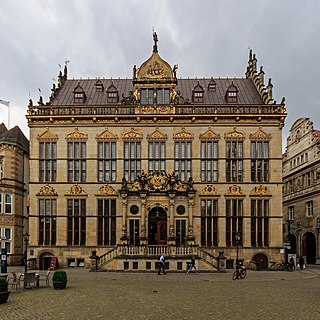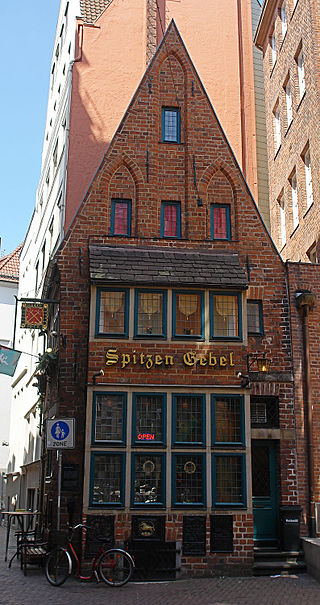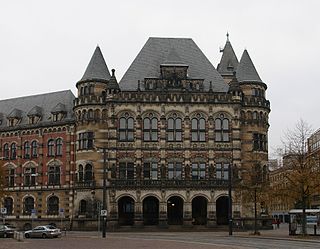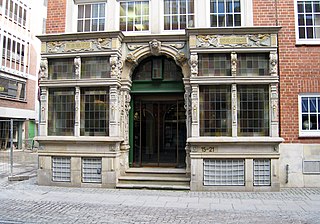
Schnoor is a neighbourhood in the medieval centre of the German city of Bremen, and the only part of it that has preserved a medieval character. The neighbourhood owes its name to old handicrafts associated with shipping. The alleys between the houses were often associated with occupations or objects: There was an area in which ropes and cables were produced and a neighboring area, where wire cables and anchor chains were manufactured.

Karstadt in Bremen is the largest department store in Bremen. It is located on Obernstrasse and Sögestrasse, in the old town in the city centre. Completed in 1932, the building was listed in 2010 as a notable example of department store architecture in the interwar period.

Haus der Stadtsparkasse is a Rococo landmark on the "Marktplatz" in Bremen, Germany. It was completed in the 1950s combining the historic front gable from another site with the more recent architecture of the remainder of the building.

The old Rathscafé, now named Deutsches Haus, is a listed building on the market place (Marktplatz) in Bremen. It is part of the monument ensemble No. 1–21.

The Bremer Marktplatz is a square situated in the centre of the Hanseatic City of Bremen. One of the oldest public squares in the city, it covers an area of 3,484 m2 (37,500 sq ft). It is no longer used as a market place except for the Christmas market and the annual Freimarkt Fair at the end of October.

The Schütting, situated on the Marktplatz in Bremen, initially served the city's merchants and tradesmen as a guild house. In 1849, it became Bremen's chamber of commerce. Since 1973, it has been under monument protection. It lies on the south site of the Bremen marketplaces directly across from the town hall.

Wilhelm Wagenfeld House is a design museum and exhibition centre in Bremen, Germany. Completed in the Neoclassical style in 1828, the building now carries the name of Bremen-born Wilhelm Wagenfeld (1900–1990), a major contributor to the 20th-century design of household objects. In addition to a collection of Wagenfeld's creations, the building hosts temporary design exhibitions. It is located in Bremen's Old Town (Altstadt) close to the Kunsthalle Bremen art museum.

Domsheide is a major square in the city of Bremen, Germany. It is located east of the Marktplatz and south of Bremen Cathedral. Streets leading to it include Ostertorstraße, Dechanatstraße, Balgebrückstraße and Violenstraße. It contains a number of important buildings, including the main post office, the courthouse, the cathedral precinct with the bell, and the annex to the stock market building. It is one of three main hubs of the public transport network, with most tram routes and two important bus lines crossing the square. The design of the Domsheide is relatively uneven, characterized by materials such as sandstone, dark red brick, red and yellow clinkers, render, concrete and marble.

Spitzen Gebel is a historic building in the centre of Bremen, Germany, located at No. 1, Hinter dem Schütting. Its origins date to the year 1400, but it was rebuilt in the Gothic style in 1590 with additions in 1610. Since 1973, it has been a listed building.

The Landgericht Bremen is the courthouse of the State of Bremen on the Domsheide in the old town of Bremen, Germany. It was built in the late 19th century in the French Renaissance style and completed in 1906. It has been a listed building since 1992. In addition to the judicial services of the regional court, the building houses sections of the Public Prosecutor's department (Staatsanwaltschaft) and of the district court (Amtsgericht).

The Essighaus was an impressive gabled town house in the old town of Bremen in northern Germany. One of the city's finest examples of Renaissance architecture, it was almost completely destroyed by bombing in 1943. The entrance flanked by projecting bay windows is the only part of the building which has been restored.

The Langenstraße is a historical street in the old town of Bremen in the north of Germany. First mentioned in 1234, it is one of Bremen's oldest streets and one of the most important for the city's merchants. It no doubt originated at the time when the first settlements grew up on the north bank of the Balge. It runs west from the Marktplatz parallel to the River Weser over Bürgermeister-Smidt-Straße to Geeren. Many of the street's historic buildings were seriously damaged during aerial bombings in the Second World War but were carefully reconstructed in the postwar period.

The Suding & Soeken building is a gabled house at No. 28 Langenstraße in Bremen, Germany. Referred to as a Kaufmannshaus or Kontorhaus, it is one of the city's few historic merchant houses to survive the war undamaged. It is noted for its projecting Renaissance bay window and its two-tiered Baroque stairway ascending from the hallway.

The Glockenspiel House is a building in Bremen in the north of Germany. With its 30 bells of Meissen porcelain, the carillon (Glockenspiel) chimes three times a day while wooden panels depicting pioneering seafarers and aviators appear on a rotating mechanism inside the tower.

The Atlantis House on Böttcherstraße in the old town of Bremen in the north of Germany is an interesting example of German architecture in the interwar period. Designed by Bernhard Hoetger, it was completed in 1931. After suffering serious war damage, it was rebuilt in 1965 with a new facade designed by Ewald Mataré.

Robinson Crusoe House is a stepped-gabled house on Böttcherstraße in the old town district of Bremen, Germany. It was built by the prosperous coffee merchant Ludwig Roselius who admired the pioneering spirit of Daniel Defoe's fictional hero Robinson Crusoe.

The House of the Seven Lazy Brothers is a historic building in Bremen, Germany, completed in 1927. With a name based on a local legend, the building located in Böttcherstraße in the old town was built by the prosperous coffee merchant Ludwig Roselius to a design by Bremen architects Eduard Scotland and Alfred Runge. The first version of the house was home to the advertising department of Roselius's coffee company and the Deutscher Werkbund association of craftsmen. When it was rebuilt in 1954 the new design was based on a traditional local story.

Eduard Scotland (1885–1945) was a German architect active in Bremen. He is remembered in particular for the Böttcherstraße houses he and his associate Alfred Runge built for the coffee merchant Ludwig Roselius.

Alfred Runge (1881–1946) was a German architect active in Bremen and its surroundings. He is remembered in particular for the Böttcherstraße houses he and his associate Eduard Scotland built for coffee merchant Ludwig Roselius.

The Focke Museum is the museum of history and the history of art for the city and state of Bremen. It was formed in 1924 by the merger of a museum of industry and commerce and the previous historical museum, and is named for the founder of the latter, Johann Focke (1848–1922), a Bremen privy councillor and father of Henrich Focke. It is located in 4.5 hectares of grounds in the Riensberg neighbourhood of the city. In addition to a main building which opened in 1964 and was extended in 2002, the museum complex includes buildings dating from the 16th to the 19th centuries.




















